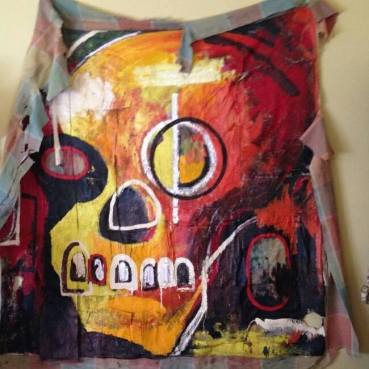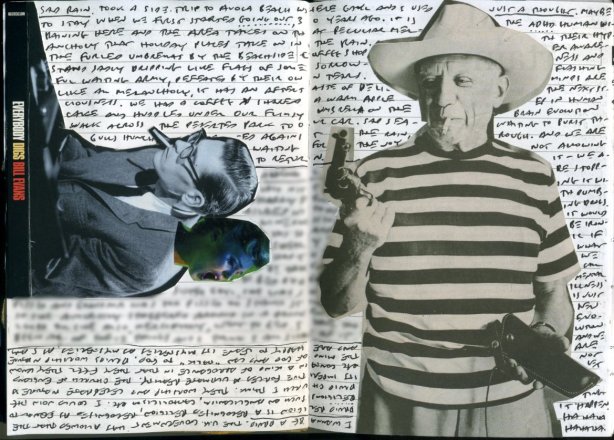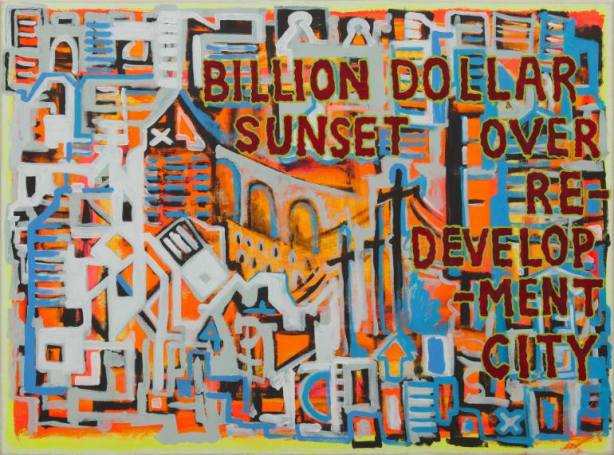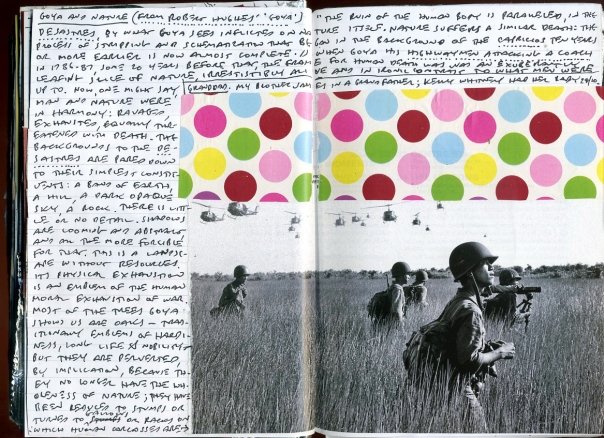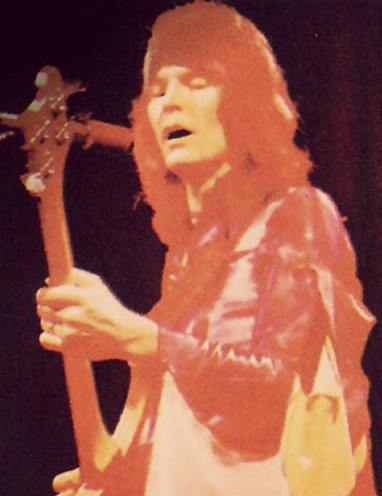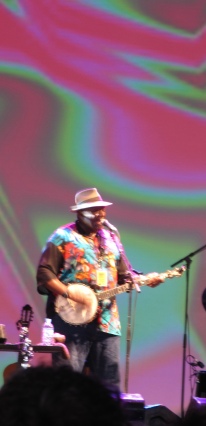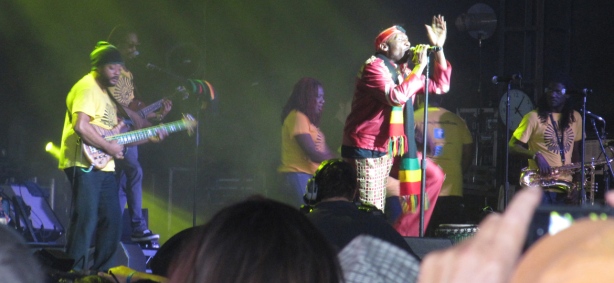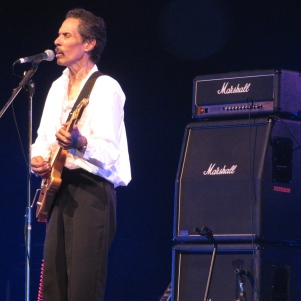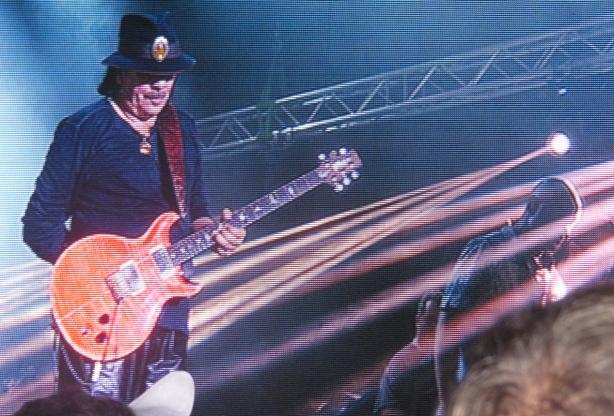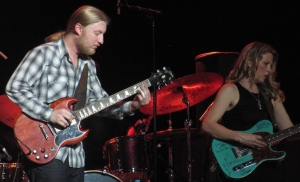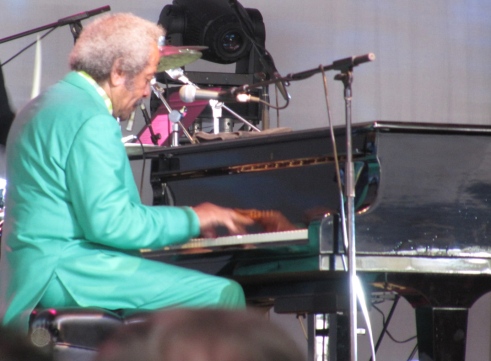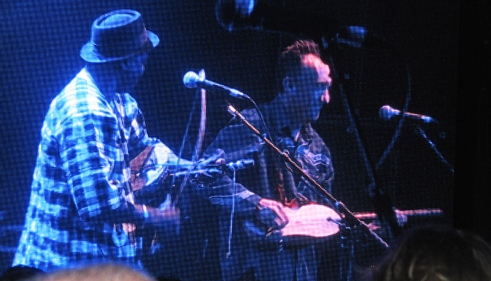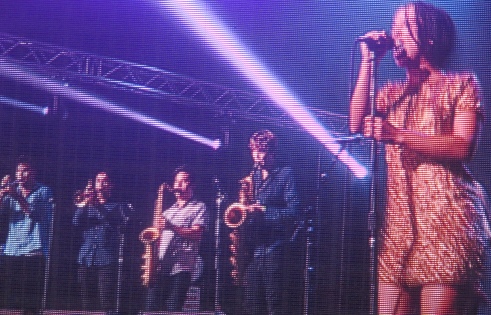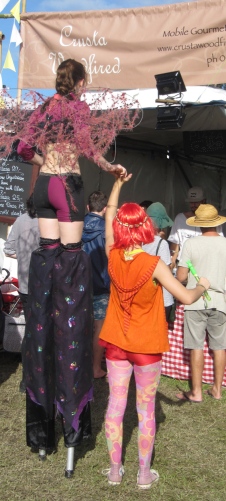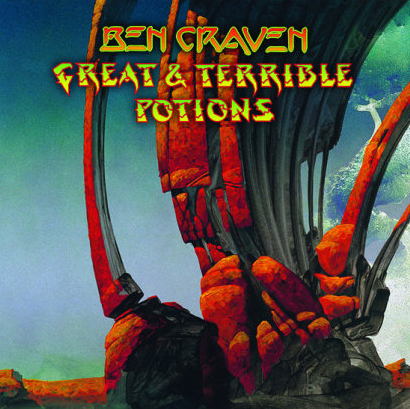In early January 2016, my fellow guitarist and artist Dirk Kruithof suggested we initiate a ‘convo’ – a conversation via email just shooting the shit about things that interest us.
Dirk is a schooled (but not too schooled!) visual artist and a far more abstract-thinking guitarist than me. I am an autodidact in most stuff I do and a pretty straight blues-jazz guitarist. We also are of different generations with a gulf of years between us.
We are alike enough yet different enough to make this interesting. I jumped at it.
I will be putting up our continuing CONVO in monthly parts for as long as it goes.
_____________________________________________________________
JH: So Dirk, we are both visual artists and both guitarists. Who started you off in guitar and in Art?
DK: So we are, as was the great Django Reinhardt!
Well I had a Primary school teacher who brought in an acoustic guitar and sung us David Bowie‘s ‘Space Oddity’ once – which made a major impression on me in 3rd class. Both the song and the instrument. I didn’t really take up guitar ’till quite a bit later, (I was around 16 years old) but that definitely planted a seed as something I’d like to do when I ‘grew up’. Before guitar was a year of Violin lessons in year 7 which I loathed!
But it was my older Brother who had the electric guitar that I first started messing around on. It was a little cheap hockshop thing and I’d go try to make sounds with it when he wasn’t home, eventually he saw how obsessed I was and let me hang onto it as he wasn’t as committed.
I also had a friend who showed me a few chords, including open D, and as things progressed I gradually got better and tried to copy anything I could from listening to recordings and the radio, or looking at books with tablature as I don’t read music. I was totally into Rock music and the guitar: Led Zeppelin and Hendrix were my idols. I also really loved the guitar work in the song Diamond Dogs that I heard on the radio. (triple m ?) Bowies recent death has really affected me.
Regarding art my Mum is a painter, so I’d say I got that from her, and I’ve been drawing on and off as long as I can remember.
My first art memories are that I’d like drawing imaginary creatures, mostly monsters in bright texta colours, but then I’d be afraid they’d come to life when I went to bed. Come to think of it Im still making brightly coloured monsters of some sort. Seeing books on Van Gogh and Francis Bacon were some of my early artistic influences.
I know you’re a big Bowie fan, – he always had such amazing unique guitarists, and all quite different from each other. I find as I get older many of my earlier influences or obsessions drop away while others remain as strong or get stronger. For me artists like Beefheart and Bowie are stayers.
Apart from Bowie do you have a long-term favourite piece of music, or piece of visual art or writing you keep coming back to?
I wonder if sentimentality plays a large part, or do the things that ‘stick’ with us have something else – we see more in them each time, or they’re capable of changing with us maybe. ?
JH: Dirk, with me it was Hendrix – totally besotted! It was that he could conjure WORLDS out of his music. This was before I ever took drugs – when I finally did, I thought “I have been here before”. I had already felt that delicious dislocate thru Hendrix’s music and all those great prog rock LP covers.
And that is the ART that grabbed me – as a boy it was Marvel Comics – Jack Kirby, Gil Kane and Steve Ditko – then as a young teen it was the art of Roger Dean and the Hipgnosis team that adorned the Yes and Pink Floyd album covers. CD covers are just too small to do anything with, but 12″ x 12″ – wow! especially as the double gatefold. (handy for seeding grass and rolling joints). I discovered the great ‘proper’ artists through all this awesome 70s graphic design. – Picasso, Dali, Miró, Bacon, particular dig Aussie Brett Whiteley.
Bowie of course took me away and gave me a reason for living during my awful private school years. Saved my life, Mr Bowie! All of his guitarists have had a big impact, but as an arranger myself, i dug Mick Ronson as he seemed to apply a composer/arranger’s ‘shaping’ to his solos. The coda of ‘Moonage Daydream’ is as lovely as the song’s melody.
They say that the music you love when you are 17 is the music you will love your whole life. I wonder if that is also true of art and literature and film?
Apart from Bowie, I do keep coming back to the Beatles, esp the creative tornado they were from ‘Rubber Soul’ onwards. I was not a Beatlemania kid – missed by a few years – but no one can deny their impact and genius (whatever that word means).
Another stayer in my life is the Hungarian composer Béla Bartok – my jazz guitar teacher in the 70s, John Robinson, opened my head right up with 20th century classical music. Stravinsky knocked me sideways but Bartok seems to resonate something deep in me – maybe my Euro heritage. I can taste the pine needles and the animal fur and the log fires in his music.
How about you? What got its hooks deep into you?
DK: Yes Hendrix — So many guitarists of all ages cite him as THE big influence, he’s an absolute untouchable and I’m no fan of the stratocaster in general. I grew up on him too. He reinvented the electric guitar and guitar music. Ive never been much of a pot smoker except my first year outta high school was the year I crammed a lifetime of it in, I was working a depressing job as a cashier at Clancys supermarket and Hendrix and Miles Davis were a big soundtrack to that time in my life. Electric Ladyland and In a Silent Way especially. I love Miles Davis.
Picasso, Stravinksy and Bartok are fantastic indeed , love ’em too — whats your European background btw?
Picasso was a major influence on Basquiat, also one of my favs.
I think as a 17 year old re-discovering Punk and its related musics had a profound impact on me that’s still having aftershocks. I’d heard Sex Pistols and Devo in primary school through my brother, and I loved the nihilism, energy and humour, the simplicity and weirdness and romanticised the idea of the anarchic outsider or rebel.
But Dead Kennedys were the one band who saved me in high school. The break-neck tempos, rawness and absolutely impolite opinionated extremism of it appealed totally, the seeming connection to Politics and what was happening in the world made alot of the old music I’d been into seem incredibly introverted, out of touch, unnecessarily clever and indulgent. That music was very anti-censorship and cheeky, and somehow also connected on that level to stuff like Zappa which I grew up with as my Dad listened to him.
And the humour of the best stuff that gets lumped into the Punk label, bad-taste, sarcastic and iconoclastic – I was hooked.
I think the stuff that stuck with me that I still listen to from that era is possibly more hybrid than strictly Punk, I still love The Fall, The Slits, Public Image LTD, The Birthday Party, Sonic Youth. Spiky guitar stuff. Captain Beefheart is an all-time favourite.
Many of the Punk bands cited Bowie and Beefheart as influences and I feel it.
Then just after high-school along came Beck (Hansen, not Jeff !).
Loved his oddball-ness, and complete mix of styles – noise hiphop folk pop etc etc. A really melodic songwriter too underneath all the gunk who had the ability like Bowie to completely change sound from album to album.
Lyrically a stream of consciousness: bizarre violent surrealism deflated in the next stanza by a dorky one-liner, next to something heart-felt. Was it all a big put-on.
I somehow connect him to Tom Waits who Is also one of my favs.
Shit the list is too exhaustive!!, next came Ornette Coleman and Free-Jazz, Be-bop, Monk and Django Reinhardt, Gypsy Music.
All that stuff is totally hooked into me for life.
I wanted to ask about your working method and thoughts on the creative process. — With your visual art, do you have a routine or regular place or time you work on it, and what do you think of the idea of ‘Inspiration’ ? — do you get influenced by new things or do you feel more self-directed and self-contained.
Im feeling increasingly that things like social media are somehow influencing my Paintings.
JH: Jesus, how could I have forgotten Miles Davis. I remember his album LIVE/EVIL utterly shocked me to the core. It was so audacious and wild. Still one I go back to when I want to shake out the kundalini.
My European background is English on my father’s side and German on my Mum’s. Went to Germany in 2009 and felt like I was ‘Home’ – there is a theory of ‘race memory’: I really resonated with the place.
My working methods are simple: find a chink of time in my day and go for it! I never a seem to need to wait for the muse or inspiration. All I need is time. Maybe if I had all the time in the world I would dry up. Ha ha.
That said, whenever I see an exhibition that thrills me – like Francis Bacon a couple of years back – I do get an extra jolt of energy. Oddly, tumultuous or joyous or significant events on my life never seem to inspire me to action. You say social media influences your paintings – maybe I am also being influenced by these external forces without ever having realised it. But when I am making something, I am really not thinking about anything but the work at hand. It’s sort of meditative.
When did your work take that pop art, urban turn? You mention Basquiat – your work brought him to mind the first time I saw it.
DK: Ahh great, yeah I was in Berlin for a couple of weeks in 2010 doing a few gigs,
I liked it too but didnt get to see nearly enough of the place.
Amongst other places went to Amsterdam (Dad’s side of the fam is Dutch) and London (Mum’s side English).
Im a big fan of the Chuck Close quote which is along the lines of ‘ Inspiration is for amateurs, the rest of us just get on with it‘ ! , I also try not to overthink it and yeah theres never enough time anyway to wait around for inspiration (whatever that is) . Just getting to work creates its own forward momentum.
I like the idea of ‘Flow Theory’ where you’re in a state of concentration, or extreme attention to something youre creating , when you are truly doing what you’re most interested in and are at your most ‘you’ and nothing else seems to matter in that moment
I studied a fine art diploma at TAFE 1999-2001 so I guess since then the Urban and Pop thing has been continually snowballing in my own work — I was an absolute Basquiat obsessive , plus I did a few major assignments on Abstract Expressionism and Pop and that’s really stuck and become a foundation for me — a lot of American stuff , also Rauschenberg, and then I got really into using Text and Words in my painting around 2001 (Christopher Wool became a big influence).
Im not sure exactly how the use of Words in my work is going to pan out, we seem to be reaching the Peak Text Art era, its kinda everywhere and overkill but Im still having fun with it.
Been looking at alot of Max Beckman lately to see how he used colour, trying to learn how to use all the colours together and still make it work.
JH: Yes, overthinking is not good. But I guess until one gets happy in one’s own artistic skin, then one tends to ‘look before you leap’ a little too much!
I remember learning jazz guitar theory and then playing all my weird modes and resolutions in the disco wedding band I was in at the time. Yep, that is a quick and harsh way to learn about ‘context’ – ha ha.
I like that idea of ‘flow theory’ – cool! and very true, we all work to get to that point, don’t we?
I need to remind you that you are dealing with a person who is very much self-taught with everything (and a living embodiment of the truism “The self-taught man has a fool for a teacher…” ha ha). Apart from a year of intense jazz guitar and two years graphic design at TAFE (my course was the certificate – nothing creative: just turning out paste-up drones for the, at that time, very labour intensive, pre-computer art and design studios). Everything else I have just picked up – constantly curious, always on the lookout.
I also need to remind you that you are dealing with a man looking at turning 60 in one year. So if i repeat myself, you will understand.
Max Beckmann? You know, he would be around number 356 on a list of artists I would look to for colour. Interesting – I really must go back to Beckmann. I usually got caught up in the power of his images and the great drawing. What have you got out of looking at Beckmann’s colours?
DK: Ha ha I havent noticed any repetition from you yet !
I was accused of it recently, I think it was alcohol related and Id forgotten I’d said the same kinda stuff to the same person one too many times after a drink!
Autodidacticism is great (like big words are), — Im fairly comfortable with the fact I’ve never had a guitar lesson. Ive thought about learning to sight- read music many times but it seems a seriously daunting prospect…
Hopefully I’m too old and set in my ways to have to start with all that. Ha yeah the Locrian, Phrygian disco wedding band! Sounds enticing. I did a stint with memorising the modes a long time ago, I think most of its still up there somewhere if I really had to use it.
So, Yeah Max Beckmann for colour seems strange right, may be its a bit like listening to Bob Dylan strictly for the sound of his voice!?
Its the late 40’s and 1950 period of his I guess Im thinking of, he got into flatter brighter colour with less tonal shading, and white , and black outlines and contrast.
Ive been using heaps of colours together in the one picture but the result seemed to be kind of weak and same-ish, all that colour together added up to a big fat monotone paradoxically — Im wanting a dramatic contrast maybe introducing black and white as well as the colours will help with that.
I guess your years of TAFE – although you werent doing particularly creative things, or having much freedom – was a real discipline in all the formal elements that would have some kind of helpful effect on your own artwork later? The collages of yours I’ve seen are great, they dont look ‘graphic-designy’ to me either (not that theres anything wrong with that!!!!) Have to add, Im a huge fan of Kurt Schwitters too.
Someone told me I should’ve been a signwriter after coming to one of my exhibitions once, wasnt quite sure how to take that !
For some reason just thought of something I read by John Cage, where he says something like: You know its modern art if you spill a can of paint on the picture and it looks like it belongs there.
Seen any good movies? I saw Hateful Eight, classic Tarantino ultraviolent and unexpected plot twists and all his favourite devices, I quite liked it.
JH: Thanx for your kudos re my collages – I really dig doing them. They are an extension of my journals (almost finished number 39!!) and yet, they still lack the freedom of my journals. At some point I seem to realise someone else will be looking at this so I self-consciously make it ART. Whereas in my journals I will for example (as I did this week) paste in a folded out Tabasco sauce box, just a flat meaningless piece of packaging – I think it’s beautiful. Whereas with my canvas art, I would then add some art element to it to make it Art.
I wish I was a brave as Robert Rauschenberg. Have you seen his ‘Cardboard’ series? Just flattened junk boxes picked up off the street. Beautiful! But then he was always like that – never afraid for his work to look like the beautiful junk it was, to show its origins quite nakedly. Apprently, he was envious of Jasper Johns for becoming popular quicker, but John’s stuff looked like Art from the outset – all sealed off and ‘finished’, whereas RR’s looked like the wind could blow it way at any moment. I love his work and he, and of course Schwitters, are my heroes. Schwitters, oddly found a happy medium between the two – his work looks ‘finished’ and yet doesn’t betray its origins – beauty in a bus ticket. Maybe its a European thing versus a brash American thing.
Your work has that collagey effect – which is why I was drawn to it: your painted pieces pull in a lot of great pop cultural elements and seem very relevant because of that. Getting back to the text thing: I love your use of text. Stuart Davis used to do those things where the names of bars and cigarettes would be part of the pic as much as a person or a tree. Picasso too, a violin with a fag pack and (I love this) fake printed woodgrain. Picasso really was doing amazing shit always way out front. What do you think of Picasso? – a lot of latter generations don’t dig him. Might be the mysoginistic thing (which is a whole other trip/conversation). I would be interested in your thoughts.
Movies? I don’t watch a lot of TV or movies. Teevee can be audiovisual lobotomy and the Hollywood movie formulaic thing really bores me. Bombastic crap where, you will notice, the reward for taking the proper moral path is always money and success (the opposite of cool Euro movies where the reward for taking the proper moral path usually ends up in more misery – YAY!). Tarantino sort of came out of the art movie tradition. Pulp Fiction I adore; Kill Bill I hated (under that lovely stylistic skin was – guess what? – more lovely stylistic skin!), Reservoir Dogs I didn’t dig – but I saw it on the heels of Pulp Fiction, so not a smart move: watched it the other night on Netflix and I liked it. Always pays to go back and reassess from different points in life, I think. Must check Django and The Hateful 8.
Have you ever seen Jodorowsky‘s El Topo (1970)? Makes Tarantino look like Walt Disney.
DK: Yes indeed Rauschenbergs boxes are great. They give you the chance to really take time to SEE them in the gallery environment , I too love that ‘Beautiful Junk’ aesthetic .
My workspace is full of bits of card, newspapers , etc all kinds of empemeral crap, Bits and pieces that then creep into the work. Sometimes copied or modified for my paintings. I like trying to put as much of ‘the real world’ as I can in there.
I appreciate Johns but not as much, though he has some knockout pieces. Schwitters is probably my favourite of the 3, and just the sheer amount of stuff he produced is astounding.
I’m assuming You’ve seen the work of Jacques Villeglé? – saw some of his 1960’s large scale torn-paper works in the Pompidou in Paris years ago , Fantastic stuff that looks like he just dragged the street into the gallery. Still looks to me as fresh as if it was made yesterday.
I do like Picasso a lot, especially his late period. It seems like whatever new painting I see, Picasso was already one of the first there with the idea.
I Saw an AGNSW Picasso show a few years back, the work was displayed in chronological order of production about 8 rooms of work, and the last 2 rooms especially really hit me… They were the best – the wildest, free-est and most child-like and expressive to my eyes, like he was doing it just for himself, no-one to impress. And great colour and spontaneity.
I like that his Paintings are autobiographical in many ways but don’t necessarily look like it (they’re not tedious to look at). Basquiat and Bacon (amongst hoardes) took alot from him too.
As far as Picasso the person — Yeah that really IS another conversation, Im constantly shocked or dissapointed with knowing too much about ‘The Greats’ (Beefheart the bully, ‘Prickasso’ etc etc)
JH: I read a lot of biography – mainly artists and musicians etc. And they are really not the nicest people – but as a friend once said (about Sinatra I think) “I don’t want to live with him, I only want to enjoy his music.” Like sportspeople or actors or I guess anyone who moves to the top, all else is sacrificed for their Art – family, lovers, children, responsibility. I think there is an awful lot of narcissism involved there, and in the case of someone like Beefheart, a measure of borderline mental illness, both exacerbated and accepted by the druggy times he lived and created in.
The messy lives of the “greats” don’t really disappoint me, as the older I get, the more I realise the truth of the Graham Greene quote: “Life is not black and white; it is black and grey.” (Hey, I’m big on the quotes today!). Everyone and everything is compromised to an extent; all my heroes sold out to some degree. The ones who have remained my great heroes are those who seemed to almost taunt their fans and their market, endangering their careers over and over again. Taking the risks that we expect from truly modern, cap-A Artists (and not having the balls to take in our own workaday lives).
Picasso, Miles Davis and yes, David Bowie to me are huge names that consistently pushed forward to the next thing, dragging us all behind them. They could have taken lethal missteps along the way, but they didn’t and in fact they became those rare and wonderful Artists who we all came to expect great and shocking innovation from with every new work. Picasso’s “Demoiselles”, collages, Neo-classic works, Miles’ “Live/Evil”, “Agartha”, even “Kind of Blue”, Bowie’s “Low” and “Young Americans” all come to mind. Still all surprisingly as shocking and fresh as the day they were made.
Of course there are many many artists who risk consistently (Rauschenberg) but the above three – being world beaters – seemed to happily risk toppling their high, high towers to chase that next impulse. Dylan is another. Career suicide seemed to be of no consequence.
Talking of careers, you are so active with your art. You have shows and exhibs and are really going at it. As someone who really hides my stuff in the cupboard, I really admire that. Do you see yourself as making it into a full-time career? Is that possible these days? I know with music it is almost impossible now. Where do you see your Art in the future?
DK: Yeah Im an avid Biography and Autobiography reader too — I really enjoy them.
Am revisting ‘Bowie , loving the alien’ (by Christopher Sandford) for the 2nd time — about 18 years after I first read it. Its definitely got its moments – I wonder how much of the info is hearsay with this particular writer. Its definitely warts and all. But then Im sure there are many books on Bowie, probably heaps more coming out now he’s died too…
Books on Kim Gordon, Patti Smith, Beefheart,Tom Waits and others Ive read recently too. And yeah of course – we dont have to live with these people, but just enjoy the ride as they appear on the written page. (Kim Gordon comes across as very un-rockstar and nice I must add .)
I love those Maverick artists that are unpredictable and strong-willed , but thats as it should be. You can kind of depend on their unpredictability. (Having said that I was not a big fan of Miles Davis’ ‘Doo-Bop’ ha hhhaaa)
Freedom, exploration , getting lost and doing what you want are some of the great luxurys of creativity. I think art is the one place you should feel free to be ‘an extremist’ and go far out on a limb. — Career Suicide is way preferable to Creative Suicide right? Although mostly those artists you’ve mentioned are at a level where they could commit it and still have some kind of a career afterwards, as they have a ‘name’.
OK I must check out Jodorowsky – My film knowledge is pretty limited, Music and Visual Art are more my thing (obviously!). I know Tarantino takes from everywhere and everyone, but I’m not always aware of all the sources.
Oh yeah making a living from music ?!?!!#@$*? I think I’ve only really done that for a couple of years out of about 25 and that involved alot of touring at that time !!! It was surviving more than living too.
Re: my own work, I’d say music is still slightly more stable and continuous for me ‘career-wise’ at present than art, but yeah I am really hoping to make more of a go of the Visual Art now too, — the last 5 years have been good as far as I’ve been exhibiting alot more, making more work that has some kind of continuity and getting a little momentum and confidence.
Mostly its been artist-run galleries and small shows, though I did do the Other Art Fair last year which was a new angle for me. (thanks for coming to that btw). I really have no idea how it will progress to a Career as much as I’d love that, but I do intend to keep having more shows in the future. I’m just drawn to making stuff, and the whole process suits my temperament, happy to work alone and self-directed and then I enjoy the feedback when people come and see the finished product.
Would you consider/ have you shown those Collages of yours in a Gallery ? I really like ’em.
JH: I have read the Beefheart and Kim Gordon and Patti Smith books. Kim Gordon seemed (as you say) a real sweetie. The Patti Smith I found great but her voice is so un-American and arty-flowery. I think she is in thrall to the European thing. Sort of surprised me, since her music is so tough.
I loved Dylan’s ‘Chronicles’ – his writing voice is really hard-edge and street and modern-American. I am not surprised, but at the same time, I didn’t expect it to be so ‘Beat’ and hip. The book I was surprised by was Viv Albertine‘s “Clothes Clothes Clothes Music Music Music Boys Boys Boys” (great title eh?) – she was from the wiry punk reggae band the Slits (one of the all-time best punk band names). She writes like (I imagine) she talks – direct, funny, conspiratorial, unfussy, unprecious. Flew thru that one.
Must borrow the Bowie biog at some stage. I have oddly never ever read a Bowie book – even though I find his music and persona utterly fascinating. Am I afraid I won’t like the unprotected and unself-curated man? Will his feet be more clay than I want to know? Ignorance is bliss; curiosity killed the cat. What the hell.
Good to hear you are having a good crack at the art thing. I went to a show that a mate of mine, Glenn Locklee participated in on Abercrombie St and I was really heartened to walk past a number of small galleries on the same street. It sparks me up to see people risking and making and shining a light in the ever-predicted dark. Every day – with art and music – there is the relentless doom and gloom barrage on the ol’ social media, often sadly justified – but venues closing rarely means the city’s creative energy dims. People keep at it, they need to scratch that itch – always the best, and most life-affirming reason for any art to be made. The balance, when it goes from being a non-career (I hate the work ‘hobby’: so dismissive of someone’s burning desire to create and speak; it ain’t fuckin stamp-collecting) to being a career, is to hold your integrity. A cliché i know – but the eternal battle, so maybe not a cliché after all.
I have always thought when one becomes a professional, it is still a good idea to be mindful of the fact that the word ‘amateur’ derives from the French, amour: to love, and not from the American sense: to not make money from. Ha ha. I am really glad that I never tried to make a living solely from music; I think it might have soured me towards the one art form that has never ever let me down.
Exhibit my own work? I have been included in a couple of emerging artist shows at Artsite, but since than have not done much. Being a (very very) late bloomer with this I really have no idea how its machinery works, but I am learning. For all those years I was satisfied to just work away on my journals and then Annalise Morrow suggested I do something outside of them. It is fun, but I need to be freer and more brave. the main thing is to DO.
The funny thing is, my visual art bears little to no relation to my music. Or maybe on some organisational level it does – I seem to gravitate towards arrangement of existing music into new forms over composition from out of the air. maybe there is a collage aesthetic at work there. Hmmmmm… I feel my music is pretty straight – blues, rock etc; never anything as beautifully noise-based as your Forenzics project.
Do you see direct correlations between your music and paintings?
DK: Hey perhaps we should do an Art show together sometime, could work thematically seeing as we are both Collagists / Musicians ?. Been wanting to exhibit some of my works on paper too, think our stuff’d work together. Could be fun.
Oh The Slits — yes love ’em , discovered them in high school — still own and love their first album ‘Cut’. A refreshing sound for ‘punk’ with the female reggae dub influence quite different to the anglo boys club of most punk. Ill swap you one Bowie for one Slits book! One of them (maybe Viv?) was John Lydon/Johnny Rotten‘s godmother too. I read Lydons ‘no Blacks, no Dogs, no Irish’ yonks ago, very good. He has another book out too.
And Bowie comes across in the book I’m reading as being pretty much un-knowable , a contradiction, a cypher, off the planet but strangely grounded and savvy too. Also a strange mix of self confident and insecure, and a bit of a sex maniac!. (but not unlikeable) — perhaps that elasticity of personality is part of the reason he was so creative. Ive seen interviews with him where he says he wants to avoid self-analysis ‘cos he feels it would get in the way of his creativity.
And he really had alot of bad contracts and business deals early on with managers and what not. Even after the Ziggy Stardust album he still only had something like 30 pounds left in the bank. I Read a book on Tom Waits a while back who too was another great enigma.
But back to Beefheart — I really started to dislike him! Which concerned me cos theres the danger it may taint my joy of the brilliance of his music.
I hadn’t thought about the origin of the word ‘Amateur’ – thats good to keep in mind. I am a fan of many of the amateur art forms — outsider art and punk , dada, free jazz, art brut. All kinds of raw and weird shit that just has to be expressed no matter if theres a polite audience , or money etc.
I find it hard to make a direct connection between my own music and art too, — People have said my paintings are rhythmic, I guess I can see that, and Im often (not always) listening to music as I make it. I went through a stage in my 20s where I was interested in synaesthesia and trying to make a painting based on a particular piece of music, but I found it quite limiting to do it so literally , and got over it pretty quickly!
Forenzics is totally improvised and a collective group process, where my paintings are usually fairly composed .
Im more conscious of the influence or correlation of the music I listen to, often while working , seeping in as opposed to the music I play myself. I would like my paintings to embody some of the rawness, energy and attitude of some of my favourite musics.
For example I’d like my paintings to look like a song by ‘The Fall‘ sounds,( I spent many a painting listening to them as I workded) — kind of frenetic and scrappy, a rant, rhythmic and critical and cryptic all at once. And the mix of textures like their production, lo-fidelity and high fidelity in the one painting. Reverbs wet and drippy or powdery and dry like different types of paint.
Other theories about artist styles are based on the influence of our cultural backgrounds. Someone recently said my work looked ‘very Dutch’. So maybe its the Madcap/drollness of the Dutch meets the smugness of the English ?!!?!
JH: I would LOVE to do that, get a Kruithof/Hardaker show up – I see a lot of similarities between our styles, approaches and attitudes in our visual work. OK, let’s def put that one on the agenda for 2016. I think these days (was it ever any different for unknowns?) you gotta do it yourself – I have been toying with the idea for a while but I haven’t really had the mojo to take it further. You’re on!
I would love to loan you the Viv Albertine/Slits book but it is on my Kindle and I can’t see any way to take it off and give it to you. Maybe there’s a hack – hell! you’re a young dude, you should know how to hack into anything! Ha ha.
It pisses me off in a way – maybe it is a trade-off for the books being so cheap and downloadable out of the air – but it pisses me off that I can’t loan them out as I could a paper (analogue) real book. God, I always loved the times when you would walk into a friend’s place with an armload of books under one arm and an armload of albums under the other, then you would walk out with the same two armloads, but now of borrowed books and albums. People used to need a wheelbarrow when they staggered out of my place some nights (didn’t get half of that stuff back but that it not really the point – it was a kind of cultural Communism: from each according to their ability to each according to their need. Ha ha).
I would love to check the Bowie tome some time. Since his death al I have heard about is his charming manner and his interest in anyone’s work he met. Very self-effacing etc. I do think though that that sort of noncommittal politeness is a shield – a kind of charm offensive in a way – “I’ll disarm them before they can get at me”. (I use it myself when faced with someone or some situation I just want to go away, I think we all do). Lou Reed just shut people out with rudeness, Warhol with that arch-ironic innocent-act. Bowie seems to have been enormously in control of everything at all times – look at the music that he pushed through with pure will; no wonder he did “Heroes” in German! And you can imagine some of the parasitical pirañas artists at his level have to deal with; factor a hypersensitive poet’s soul into that and yes, a shield of some sort is imperative!
I am reading a book right now about Robert Lowell the American poet and he talks about two kinds of poetry, “The cooked and the raw”. This came about when, in the late 50’s he, as an academic established poet felt threatened by the new wild Beat poetry of Ginsberg and Corso etc. It says a lot that he didn’t hide behind his academic kudos but felt as if he needed to really check out what the young firebrands were doing, even though their language was anathema to his classic sensibilities.
“The cooked” (that is, the calmly thought out and highly technically finished) “and the raw” (that is, the instinctively expressed and raw-boned and rough in execution) can be of course applied to anything. You are of the post-punk generation, I am of the pre-punk generation (in a huge generalisation, but for discussion’s sake). The Fall shocks me as I am sure Steely Dan or the jazzier Santana bore you. Punk really drove a wedge between the cooked and the raw and seems to have set up a background radiation to everything since. What is it about Punk (art/music/literature/design/language) that thrilled you so? I know the clichés but I rarely get the chance to ask someone who avoids clichés.
DK: Ok great , that’s exciting, lets make it happen — lets keep our eyes out for a space to show. Yeah it’ll have to be a d.i.y. affair, so long as we have decent lighting I’m ok with being flexible about a venue. Im pretty much all over the shop at the mo’ till the middle of the year with my Painting show, gigs and various Dad duties etc, but I’ll def keep it in mind and on the lookout , if it suits You we can do something in the second half of the year.? We could call the show THE CONVO.
No worries re the Slits book, Im still exclusively a paper book reader (so far) and Im sure I can find a copy of it around the place — Id say you’re more tech savvy than me , Im yet to use kindle! Am a ‘late-adopter’ as they say. I’ll be the guy who gets the barcode/ ID implant in his arm 5 years after everyone else…
Oh yeah how hilarious is Lou Reed (Too Rude) in some of those old interviews, very effective at keeping them painfully short !!!
I’ll get that Bowie book to you soon too, almost finished it.
Ive heard about ‘The cooked and the raw’, never read it myself. Sounds like a good read . I really like the idea, — it can be applied to so many modern (and earlier) artforms I guess – from Impressionism , fauvism onwards to punk, certain types of hip-hop etc.
In some ways thats what so many ‘new’ forms appear to do isnt it, to break away from the established in that raw impulsive way, though obviously those new forms ‘Beat Poetry’ etc often become their own version of the classics in time.
Punk / Post-Punk has certainly had so much air-time now historically speaking, its almost become an influence on everything and anything , a very broad and kind of meaningless (confused) term. And yes so many Cliches involved too, a rebellion that became a uniform for many!.
I was listening to Santana (I still quite like ‘Abraxas’) Mahavishnu, Pink Floyd and Steely Dan (!!) around the time I found Punk, and was a weird teen who loved that variety in listening to seemingly mutually-exclusive stuff.
Over a few years the punk related stuff became a MUCH larger and more important influence, and has remained with me more strongly, I think partly because it feels like I ‘discovered it ‘ myself as opposed the ‘inherited’ it ( the Zappa, Zeppelin, and others I got from my Dad and Brother).
And now chucking on The Fall when I paint is kinda the equivalent of having a Coffee in the morning, so familiar and ritualistic. The Fall are the best because they are the most unique, artistic, literary or poetic, sci-fi and weird cryptic stream-of-consciousness band of the Punk era. Their mid-period era they are a seriously mean machine, the link from Velvet Underground to Sonic Youth to a weird gonzo-journalist type reportage. Punk is now Nostalgic for me even ? Oh No. !!!
The other thing I responded to as a young impressionable was the feeling of ‘danger’ and confrontation of Punk, — I heard a live Iggy Pop/ Stooges album and he’s saying stuff on the mic to a really hostile crowd who are heckling him, stuff like ‘You’re paying 5 dollars and Im making 300 so screw ya, ya jealous cocksuckers!‘ or ‘Your girlfriend still loves me’ .
The album was really funny and kinda desperate, and just raw and real stuff you’d never get on ‘Live at Pompeii’, or ‘Song remains the same’ say. The performer and audience communicating so directly. I suppose its more Romanticism as opposed to Classicism. The Cinema Verite quality of punk appeals to me, — you can see the structure, the raw bones and the struggle of the process are right there on the surface as part of the work, not out of view and made into a perfect object.
The best of it feels unbalanced, unpredictable and energised. Embracing and turning all the negative emotions and anger and frustration and absurdities of life into a positive — into ART, it’s an idea I LOVE. I think of my own artwork sometimes as ‘Wallowing’ in certain negatives, but it’s bringing something to life.
Thats how alot of that Punk stuff felt like to me, though now I do think most art has a fair degree of Illusion , you can eggagerate those features and maybe they are not so ‘genuine’ after all. But Punk was aware of that too, — sometimes dealing in an ironic cartoon-like quality that exploited itself.
Oh I just had a thought … My Dad loves Bob Dylan obsessively and of course I had to rebel from that ! — though maybe Dylan was punk too when he first went electric.
So are you a Bob Dylan fan ? , I know he’s important to alot of people
JH: Dylan? You reckon you are a late adopter? I only got into Dylan maybe 4 years ago, age 55!
Even though he was a cultural beacon of his age and a superstar of my early teenage I never paid much mind to him. I was a jazz geek, one of those guys who ‘don’t ever really listen to the words’ (which is why i could stomach my relentless diet of Prog and jazz-fusion – mainly lyrics written by Scientologists, academics or space-cadets… aaaaargh). Of course he was in and out of my life – an artist as ubiquitous as him seemed to always bob up (pardon the pun) either on radio or magazines, teevee etc. (His conversion to born-again Christianity in the mid-70s was front page news – it seemed the earth itself had tilted from its axis – funny, i bought his best ‘Christian’ album two days ago, Slow Train Coming and away from all the brouhaha it is a great, funky blues album.)
Also, Dylan’s true impact was felt in the mid-Sixties, so he was a little early for me – Dylan was of the Hippie counterculture, Bowie and T. Rex were my guys. Bowie transmitted all the righteous info, the news fit to read, the arcane secrets, the permissions, the proper highway signs etc to me, just as Dylan had done to his Sixties tribes.
In one of those weird cultural ‘wrinkles’ which the 21st century seems to have more and more of every day, my son got me into Dylan after hearing the 1964 song ‘The Times They are A-Changing’ on the soundtrack of the 2009 superhero movie, Watchmen. He seemed attracted to the rawness and immediacy, the lo-fi and the radicalism of this song – all very Punk attributes. He asked me who it was – and i told him, and he got into a lot of the early Dylan albums. My son finds a lot of the music of his time plastic and cook-cutter.
So it set me on a path to Dylan and I really became absorbed in the ‘Blonde On Blonde’ stuff – but there are 2 distinct Dylans: the surrealist poet and the earthy folkie: and unlike most artists bands who have 2 distinct periods, set chronologically (Pink Floyd, Stones), Dylan seems to mix and match thru his career. Which kinda keeps it interesting. And I listen to the lyrics.
What I also found I liked about this music was its rootsiness – and I horrified myself. For years I had been decrying that clichéd arc whereby at a certain age, we all get all woodsy and acoustic and folky and rootsy. Jesus, even David Johansen of the NY Dolls went acoustic! To me, it was a symptom of becoming a scared old man (or woman) and retreating to some imagined hippie arcadia away from all the fast-digital pace of modern life. I abhorred it, it was fake-nostalgic and plain weak. And yet, here was I doing it.
Am I pining for an imagined paradise of combi vans, cannabis and muesli? I doubt it, but the older I get, the more I move away from technicality and more into groove and feel. And direct emotional input – i think that is the thing. But Mark Rothko can be direct emotional input as well as Howlin’ Wolf, so the feast is still a wide table.
The current blues and roots scene to me though is overloaded with fake-authenticity – Blind Boy This and Blind Boy That, all wrapped in faux-faded leather and (the stupidest of the stupidest) factory-relic’d guitars.
Am I being ornery? After all, every scene (even pure fine arts) has its showbiz aspect. And we wouldn’t be true to ourselves if we didn’t admit that some of the greatest names of 20th century art (and/or their dealers) milked that showbiz aspect for all it was worth – Dali, Pollock, Warhol (although he obviously turned it in on itself), Koons. What think you?
DK: Ah yeah T-Rex ! The Slider was one of the first cassettes I remember buying in Primary school. (around 1982 or so) Still have it and still love it ! (and it still plays suprisingly well on my found-on-the-streets-of-darlo ghetto blaster that sits in my painting room ). There’s an American singer I came across recently, Ty Segal who’se been doing kind of garage-y rock versions of T-Rex, I quite like it (suprisingly) – and more so quite like his own stuff too. He somehow manages that rare thing of having a quite retro (psych?) sound but not sucking.
I’m pretty sure my Dad owned everything Dylan ever did, I remember all those albums you’ve mentioned. Ive listened to a few things over the years, maybe one day I’ll really make an effort to properly discover him.
I also don’t mind some rootsy acoustic stuff — generally I find if theres a few influences in there and its not all too earnest and one-dimensional (overly fake authentic) I can cope. Have been listening to Micah P. Hinson quite a bit lately I think he’s quite good.
I know exactly what you mean about fake nostalgia music and all that weathered guitars shit, ‘authentic roots’, its pretty ridiculous… The problem I find with a lot of that stuff is its so damn humourless, dull and generic. And bland. The best singer/songwriters to me at least have some personality in there, whatever style it is.
I agree with your Son that theres alot of cookie cutter crap about, but its probably always been the case at any point in time.
I dont mind the showbiz aspect at all if its done by an artist whose work I like: You have to get it out there and get known somehow. I s’pose with publicity and image etc. its the old ‘not what you do its the way you do it’ thing that comes into play… I also think if I like a particular work or Artist, I tolerate things of that ‘showbiz’ nature thatd probably bother me in another artist / work that I don’t like!
I think its part of the job to have strong opinions about music if you’re interested in it. Im guilty of it plenty. Just looked up ‘Ornery’ and the dictionary says it stems from ‘Ordinary’, (not sure if theres a point in that observation in this context btw).
Will have to check out the David Johansen acoustic stuff now you mention it.
Btw speaking of ‘roots’ music — I’ve read ‘Here comes everybody’ , a great book by the Accordionist of The Pogues (forgotten his name now) about his time in the band. Fan or not (I’m a fan) I think its a good read.
